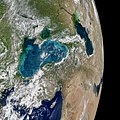|
Afrikaans: Meeste somers verskyn hierdie juweelkleurige skakerings in die Swart See. Die turkoois warrels is nie die kwashale van 'n skildery nie; hulle dui op die teenwoordigheid van fitoplankton, wat in sigbare waterstrome en -werwels manifesteer. Op 29 Mei 2017 het die Matige Resolusie Afbeelding-spektroradiometer (MODIS) op NASA se Aqua-satelliet hierdie beelddata van 'n voortdurende fitoplanktonbloei in die Swart See vasgevang. Die beeld is 'n mosaïek, saamgestel uit herhaalde satelliet-oorgange. Fitoplankton is drywende, mikroskopiese organismes wat hul eie kos uit sonlig en opgeloste voedingstowwe maak, en hier vloei genoegsame voedingstowwe uit o.m. die Donau- en Dnieperrivier in die Swart See. Oor die algemeen onderhou fitoplankton vis, skulpvis en ander mariene organismes. Groot, gereelde opbloei kan egter lei tot eutrofikasie – die verlies van suurstof uit die water – en kan eindelik die seelewe versmoor. Een soort fitoplankton wat algemeen in die Swart See voorkom, is kokolitofore—mikroskopiese plankton wat met wit kalsiumkarbonaat oortrek is. Wanneer dit in grootmaat aangroei, is hierdie reflektiewe plate opvallend uit die ruimte sigbaar as helder, melkerige water. "Die toename in reflektiwiteit in Mei in die Swart See, met 'n hoogtepunt in Junie, is in ooreenstemming met resultate van ander jare," het Norman Kuring, 'n oseaanwetenskaplike by NASA se Goddard-ruimtevlugsentrum, gesê. Hoewel Kuring nie dié streek bestudeer nie, is die opbloei vanjaar (d.i. somer 2017) een van die helderste wat hy sedert 2012 opgemerk het.
Ander soorte fitoplankton kan baie anders lyk in satellietbeelde. "Dit is belangrik om te onthou dat nie alle fitoplanktonopbloeie die water helderder maak nie," het Kuring gesê. "Diatome, wat ook in die Swart See opbloei, is geneig om water donkerder eerder as helderder te maak."
Čeština: V letním období se na Černém moři objevují barevné oblasti připomínající tahy malířským stětcem. Ve skutečnosti představují tyrkysově zbarvené plochy oblasti s vysokým výskytem fytoplanktonu, které kopírují vodní prody a víry.
English: Most summers, jewel-toned hues appear in the Black Sea. The turquoise swirls are not the brushstrokes of a painting; they indicate the presence of phytoplankton, which trace the flow of water currents and eddies.
On May 29, 2017, the Moderate Resolution Imaging Spectroradiometer (MODIS) on NASA’s Aqua satellite captured the data for this image of an ongoing phytoplankton bloom in the Black Sea. The image is a mosaic, composed from multiple satellite passes over the region.
Phytoplankton are floating, microscopic organisms that make their own food from sunlight and dissolved nutrients. Here, ample water flow from rivers like the Danube and Dnieper carries nutrients to the Black Sea. In general, phytoplankton support fish, shellfish, and other marine organisms. But large, frequent blooms can lead to eutrophication—the loss of oxygen from the water—and end up suffocating marine life.
One type of phytoplankton commonly found in the Black Sea are coccolithophores—microscopic plankton that are plated with white calcium carbonate. When aggregated in large numbers, these reflective plates are easily visible from space as bright, milky water.
“The May ramp-up in reflectivity in the Black Sea, with peak brightness in June, seems consistent with results from other years,” said Norman Kuring, an ocean scientist at NASA’s Goddard Space Flight Center. Although Kuring does not study this region, the bloom this year is one of the brightest to catch his eye since 2012.
Other types of phytoplankton can look much different in satellite imagery. “It’s important to remember that not all phytoplankton blooms make the water brighter,” Kuring said. “Diatoms, which also bloom in the Black Sea, tend to darken water more than they brighten it.”
Español: Vista satelital del mar Mediteraneo (abajo), el mar Negro (centro) y el mar Caspio (arriba). En el mar Negro a menudo aparacen tonos turquesas durante el verano. Estos indican la presencia de fitoplancton, que rastrea el flujo de las corrientes de agua.
Português: Vista por satélite do mar Mediterrâneo (abaixo), do mar Negro (centro) e do mar Cáspio (acima). No mar Negro, tons de turquesa aparecem frequentemente durante o verão. Estes indicam a presença de fitoplâncton, que rastreia o fluxo das correntes de água.
Русский: Спутниковая фотография Чёрного моря. Видны также Каспийское, Средиземное и Азовское моря. Бирюзовые фигуры на фото указывают на наличие фитопланктона в Чёрном море.
اردو: بحیرہ اسود میں اکثر موسم گرما میں جواہرات نما رنگ آ جاتے ہیں۔ فیروزی رنگ کے بھنور کسی برش کی پینٹنگ نہیں ہے؛ یہ نبات تیراکہ کی موجودگی کو ظاہر کرتے ہیں، جو پانی کی دھاراؤں اور گردابوں کے بہاؤ کا پتہ لگاتے ہیں۔ |







